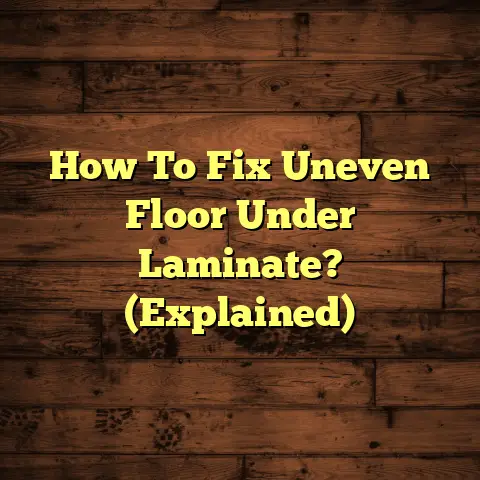Outdoor Tile Designs That Wow (4 Cracking Problems!)
Imagine stepping onto a gorgeous tiled patio, feeling the warmth of the sun, and knowing you’ve created a space that’s both beautiful and functional.
But let’s be real – outdoor tile projects aren’t always a walk in the park. There are potential pitfalls that can turn your dream oasis into a maintenance nightmare.
That’s why I’m here to share my expertise and guide you through the four biggest problems I’ve encountered with outdoor tile designs.
Ignoring these issues can lead to costly repairs, aesthetic disappointments, and a whole lot of frustration. Trust me, I’ve seen it all!
So, grab a coffee, settle in, and let’s dive into how to create an outdoor space that truly wows, while avoiding these common headaches.
Section 1: Problem #1 – Cracking and Breakage
1.1 Understanding the Causes
Tile cracking – it’s the bane of any homeowner’s existence. But what exactly causes those unsightly cracks in your beautiful outdoor tiles?
Well, it’s usually a combination of factors, with environmental stress and improper installation leading the charge.
Think about it: your outdoor tiles are constantly exposed to the elements. Temperature fluctuations, especially in climates with harsh winters or scorching summers, can cause the tiles to expand and contract.
This constant stress can weaken the tile over time, leading to cracks. Moisture is another big culprit. Water can seep into the tile and freeze, causing it to expand and crack from the inside out.
According to the Tile Council of North America (TCNA), proper substrate preparation is crucial to preventing cracking.
A poorly prepared substrate can lead to uneven settling, which puts stress on the tiles and increases the risk of cracking.
I’ve seen countless projects fail because the contractor skimped on this crucial step.
1.2 Real-life Examples
Let me share a story about a homeowner I worked with a few years back. They had a beautiful backyard patio tiled with porcelain. It was the perfect spot for summer barbecues and relaxing evenings.
However, after the first winter, they noticed several tiles had cracked. It was devastating! After investigating, I discovered the original contractor hadn’t properly prepared the sub-base.
The patio was built on compacted soil without proper drainage or a reinforced concrete slab. As the ground shifted with freeze-thaw cycles, the tiles couldn’t handle the stress.
The result? A cracked and unsightly patio that needed extensive repairs. Here’s another example, this time from my own neighborhood.
A neighbor decided to install slate tiles around their pool. They looked stunning at first, but within a year, hairline cracks started appearing.
The problem? Slate, while beautiful, is a naturally layered stone. In freezing temperatures, water seeped between the layers, expanded, and caused the slate to delaminate and crack.
These real-life examples highlight the importance of understanding the specific challenges of outdoor tile installations and choosing the right materials and installation techniques.
1.3 Long-term Consequences
Cracked tiles aren’t just an aesthetic problem; they can lead to more serious issues down the road.
Once a tile cracks, it creates a pathway for water to infiltrate the underlying structure. This can lead to water damage, mold growth, and even structural instability.
Imagine water seeping into the foundation of your patio or walkway, causing it to crumble over time. The cost of repairing water damage can quickly escalate, far exceeding the initial cost of proper tile installation.
According to the American Society of Civil Engineers (ASCE), water damage is a leading cause of structural failure in buildings.
Addressing cracked tiles promptly can prevent these long-term consequences and save you a lot of money and headaches in the future.
Section 2: Problem #2 – Slippery Surfaces
2.1 Identifying Risk Factors
Okay, let’s talk about safety. No one wants to slip and fall on their outdoor patio, especially in areas prone to rain or snow.
Choosing the right tile with the proper texture and finish is crucial for preventing accidents. Some tiles are simply more slippery than others.
For example, polished porcelain or glazed ceramic tiles can become incredibly slick when wet. They look beautiful, but they’re not the best choice for outdoor areas.
The key is to look for tiles with a textured surface, such as those with a matte finish, or those specifically designed for outdoor use with slip-resistant properties.
The Dynamic Coefficient of Friction (DCOF) rating measures a tile’s slip resistance. A higher DCOF rating indicates better slip resistance.
According to ANSI A137.1, the standard for ceramic tile, tiles used in wet areas should have a DCOF of 0.42 or higher.
2.2 Impact on Safety
Slippery tiles can pose a serious safety hazard, especially for children, the elderly, and anyone with mobility issues.
Slips and falls can result in fractures, sprains, and even head injuries. According to the National Safety Council (NSC), falls are a leading cause of injury in the United States.
In fact, the Centers for Disease Control and Prevention (CDC) reports that millions of people are treated in emergency rooms each year for fall-related injuries.
Imagine hosting a summer barbecue and having a guest slip and fall on your slippery patio. It’s a homeowner’s worst nightmare!
Choosing slip-resistant tiles is a simple way to prevent accidents and ensure the safety of your family and guests.
2.3 Design Solutions
Fortunately, you don’t have to sacrifice aesthetics for safety. There are plenty of beautiful and slip-resistant tiles available on the market.
For example, textured porcelain tiles mimic the look of natural stone while providing excellent slip resistance.
Stone tiles like slate and sandstone naturally offer good traction, but it’s important to choose a variety with a slightly rougher surface.
I’m also seeing a growing trend of using tiles with textured patterns or raised designs to enhance grip. These tiles not only look great but also provide added safety.
Another option is to incorporate non-slip mats or runners in high-traffic areas, such as near doorways or steps.
By carefully considering both aesthetics and safety, you can create an outdoor space that’s both beautiful and functional.
Section 3: Problem #3 – Fading Colors and Patterns
3.1 Understanding Fading
Imagine investing in vibrant, colorful outdoor tiles, only to see them fade and lose their luster after just a few seasons. It’s a common problem, and it’s often caused by exposure to UV rays and general wear and tear.
The sun’s ultraviolet (UV) rays can break down the pigments in certain tiles, causing them to fade over time.
Darker colors, like blues and blacks, tend to be more susceptible to fading than lighter colors. Climate also plays a role.
Areas with intense sunlight and extreme temperature fluctuations can accelerate the fading process.
The type of tile material also matters. Some materials, like natural stone, are more resistant to fading than others.
Porcelain tiles, especially those with a through-body color (meaning the color goes all the way through the tile), tend to hold their color better than ceramic tiles with a surface glaze.
3.2 Aesthetic Implications
Faded tiles can detract from the overall look of your outdoor space, making it appear dull and outdated.
Imagine a once-vibrant patio now looking washed out and lackluster. It can significantly impact the curb appeal of your home and diminish your enjoyment of the space.
I’ve seen homeowners spend thousands of dollars on outdoor tile installations, only to be disappointed when the colors fade within a few years.
It’s important to choose tiles that are specifically designed for outdoor use and are known for their fade resistance.
Before-and-after photos can be a powerful way to illustrate the effects of fading. Seeing the dramatic difference between a newly installed tile and one that’s been exposed to the elements for several years can be eye-opening.
3.3 Durability and Longevity
When it comes to outdoor tiles, durability and longevity are key. Investing in high-quality tiles that are fade-resistant will save you money and headaches in the long run.
Look for tiles that are labeled as “UV-resistant” or “fade-resistant.” These tiles are specifically designed to withstand the harsh effects of the sun.
Also, consider the tile’s PEI (Porcelain Enamel Institute) rating, which measures its resistance to abrasion. A higher PEI rating indicates greater durability.
Some brands are known for their high-quality outdoor tiles and their commitment to color retention. Researching different brands and reading customer reviews can help you make an informed decision.
Remember, choosing the right tiles from the start can prevent fading and keep your outdoor space looking beautiful for years to come.
Section 4: Problem #4 – Grout Issues
4.1 Common Grout Problems
Grout – it’s the unsung hero (or villain) of any tile installation. While it might seem like a minor detail, grout plays a crucial role in the overall look and performance of your outdoor tile.
Unfortunately, grout is prone to several problems in outdoor environments, including cracking, discoloration, and mold growth.
Cracking is often caused by temperature fluctuations and moisture exposure. As the tiles expand and contract, the grout can become stressed and crack.
Discoloration is another common issue. Grout can absorb dirt, stains, and mildew, causing it to look dingy and unsightly.
Mold and mildew thrive in damp environments, making outdoor grout a prime target. These unsightly growths can not only ruin the appearance of your tile but also pose health risks.
The quality of the grout and the installation techniques used can significantly impact these issues.
Using a low-quality grout or failing to properly seal the grout can increase the risk of cracking, discoloration, and mold growth.
4.2 Maintenance Challenges
Maintaining grout in outdoor environments can be a real challenge. It requires regular cleaning and sealing to prevent problems from developing.
Outdoor grout is constantly exposed to the elements, making it more susceptible to dirt, stains, and mildew.
Rain, snow, and sunlight can all contribute to grout deterioration. Cleaning grout can be a time-consuming and labor-intensive task.
It often requires special cleaning solutions and brushes to remove stubborn stains and mildew.
Even with regular cleaning, grout can still become discolored over time, requiring more intensive treatments like grout staining or replacement.
Weather conditions can exacerbate grout issues. Freezing temperatures can cause grout to crack, while humid conditions can promote mold growth.
4.3 Choosing the Right Grout
Choosing the right grout is essential for preventing problems and ensuring the longevity of your outdoor tile installation.
Look for grouts that are specifically designed for outdoor use and are labeled as “weather-resistant” or “mold-resistant.”
Epoxy grouts are a popular choice for outdoor applications because they are highly durable, water-resistant, and stain-resistant.
They are also less prone to cracking and discoloration than traditional cement-based grouts.
However, epoxy grouts can be more expensive and more difficult to install. Cement-based grouts with polymer additives can also provide good performance in outdoor environments.
These grouts offer improved water resistance and flexibility compared to traditional cement-based grouts.
The latest innovations in grout technology include grouts with built-in antimicrobial properties that inhibit the growth of mold and mildew.
These grouts can significantly reduce the need for frequent cleaning and maintenance.
Conclusion: The Path to Stunning Outdoor Spaces
So, there you have it – the four cracking problems that can plague outdoor tile designs. But don’t let these challenges discourage you!
With the right knowledge and preparation, you can create a stunning outdoor space that will wow everyone who sees it.
Remember, understanding the causes of cracking, slippery surfaces, fading colors, and grout issues is the first step in preventing them.
By choosing the right materials, hiring a qualified contractor, and following proper maintenance procedures, you can ensure that your outdoor tile installation stands the test of time.
Your outdoor space deserves to shine – don’t let these problems hold you back from achieving the stunning design you’ve always envisioned!
Dive into the world of outdoor tiles with confidence, knowing you are prepared to tackle the challenges head-on!





